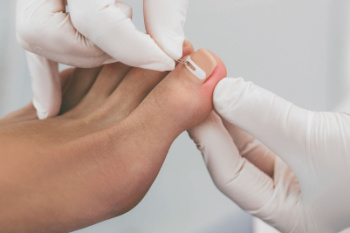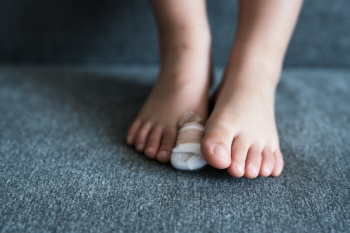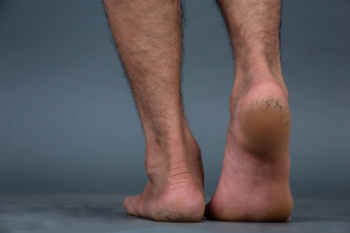April 2024
The Anatomy and Causes of Bunions

Bunions, medically known as hallux valgus, are a foot deformity that affects the joint at the base of the big toe. This condition occurs when the bone or tissue at the joint shifts out of place, causing the big toe to lean inward toward the other toes. The anatomy of a bunion involves the misalignment of the metatarsophalangeal, known as the MTP, joint that leads to a bony bump on the side of the foot and the deviation of the big toe. Several factors contribute to the development of bunions, including genetics, improper footwear, and structural foot abnormalities. Individuals with a family history of bunions are more predisposed to developing them, as are those who frequently wear tight or narrow shoes that squeeze the toes together. Additionally, conditions, such as flat feet or low arches, can increase the risk of bunions by placing excessive pressure on the MTP joint. Understanding the anatomy and causes of bunions is helpful for effective prevention and treatment strategies. If you have a bunion, it is suggested that you consult a podiatrist who can offer you effective management techniques.
If you are suffering from bunion pain, contact Steven Spivak, DPM of Mount Holly Family Footcare. Our doctor can provide the care you need to keep you pain-free and on your feet.
What Is a Bunion?
Bunions are painful bony bumps that usually develop on the inside of the foot at the joint of the big toe. As the deformity increases over time, it may become painful to walk and wear shoes. Women are more likely to exacerbate existing bunions since they often wear tight, narrow shoes that shift their toes together. Bunion pain can be relieved by wearing wider shoes with enough room for the toes.
Causes
- Genetics – some people inherit feet that are more prone to bunion development
- Inflammatory Conditions - rheumatoid arthritis and polio may cause bunion development
Symptoms
- Redness and inflammation
- Pain and tenderness
- Callus or corns on the bump
- Restricted motion in the big toe
In order to diagnose your bunion, your podiatrist may ask about your medical history, symptoms, and general health. Your doctor might also order an x-ray to take a closer look at your feet. Nonsurgical treatment options include orthotics, padding, icing, changes in footwear, and medication. If nonsurgical treatments don’t alleviate your bunion pain, surgery may be necessary.
If you have any questions, please feel free to contact our office located in Lumberton, NJ . We offer the newest diagnostic and treatment technologies for all your foot care needs.
Ingrown Toenail Surgery

Ingrown toenails can be a literal pain, causing discomfort and sometimes infection. Fortunately, there are surgical solutions such as nail avulsion and wedge excision. Nail avulsion involves removing the entire nail or part of it, providing relief by preventing further ingrowth. This procedure is commonly used when the ingrown nail is recurring or severe. Conversely, wedge excision involves removing a portion of the nail along with the underlying tissue. It aims to eliminate the ingrown part while preserving the appearance and function of the nail. Both procedures are typically performed under local anesthesia, ensuring minimal discomfort for the patient. Following either procedure, proper post-operative care is vital in promoting healing and preventing complications. Ultimately, nail avulsion and wedge excision offer effective solutions for those suffering from the discomfort of ingrown toenails, providing relief and restoring comfort to daily activities. If you have an ingrown toenail, it is suggested that you speak to a podiatrist who can help you decide if one of these types of foot surgery is right for you.
Foot surgery is sometimes necessary to treat a foot ailment. To learn more, contact Steven Spivak, DPM of Mount Holly Family Footcare. Our doctor will assist you with all of your foot and ankle needs.
When Is Surgery Necessary?
Foot and ankle surgery is generally reserved for cases in which less invasive, conservative procedures have failed to alleviate the problem. Some of the cases in which surgery may be necessary include:
- Removing foot deformities like bunions and bone spurs
- Severe arthritis that has caused bone issues
- Cosmetic reconstruction
What Types of Surgery Are There?
The type of surgery you receive will depend on the nature of the problem you have. Some of the possible surgeries include:
- Bunionectomy for painful bunions
- Surgical fusion for realignment of bones
- Neuropathy decompression surgery to treat nerve damage
Benefits of Surgery
Although surgery is usually a last resort, it can provide more complete pain relief compared to non-surgical methods and may allow you to finally resume full activity.
Surgical techniques have also become increasingly sophisticated. Techniques like endoscopic surgery allow for smaller incisions and faster recovery times.
If you have any questions please feel free to contact our office located in Lumberton, NJ . We offer the newest diagnostic and treatment technologies for all your foot and ankle needs.
Symptoms and Diagnosis of Toe Fractures

Toe fractures, though often overlooked, can cause significant discomfort and inconvenience. Whether it is the big toe or one of the smaller ones, any part of the toe can become fractured due to trauma or repetitive stress. Symptoms typically include pain, swelling, bruising, and difficulty bearing weight. In severe cases, the toe may appear deformed or misaligned. Diagnosing a toe fracture involves a thorough physical examination and possibly imaging tests such as X-rays. Your podiatrist will assess the extent of the injury and determine the best course of treatment, which may include rest, elevation, and immobilization with a splint or buddy taping. In some cases, if the fracture is severe or displaced, surgery may be necessary to realign the bones and promote proper healing. If you have symptoms of a broken toe, it is suggested that you seek prompt medical attention from a podiatrist who can effectively treat this condition.
Broken toes may cause a lot of pain and should be treated as soon as possible. If you have any concerns about your feet, contact Steven Spivak, DPM from Mount Holly Family Footcare. Our doctor will treat your foot and ankle needs.
What Is a Broken Toe?
A broken toe occurs when one or more of the toe bones of the foot are broken after an injury. Injuries such as stubbing your toe or dropping a heavy object on it may cause a toe fracture.
Symptoms of a Broken Toe
- Swelling
- Pain (with/without wearing shoes)
- Stiffness
- Nail Injury
Although the injured toe should be monitored daily, it is especially important to have a podiatrist look at your toe if you have severe symptoms. Some of these symptoms include worsening or new pain that is not relieved with medication, sores, redness, or open wounds near the toe.
If you have any questions, please feel free to contact our office located in Lumberton, NJ . We offer the newest diagnostic and treatment technologies for all your foot care needs.
Symptoms and Risk Factors of PAD Affecting the Feet

Peripheral artery disease, or PAD, manifests in various ways, often affecting the feet profoundly. Symptoms of PAD in the feet can include pain, cramping, or numbness, particularly during physical activity like walking or climbing stairs, which subsides with rest. In severe cases, individuals may experience non-healing wounds or ulcers on the feet or toes, indicating compromised blood flow. Several risk factors contribute to the development of PAD, including smoking, diabetes, high blood pressure, high cholesterol, and advancing age. Additionally, individuals with a sedentary lifestyle or those with a family history of cardiovascular disease are at increased risk. PAD occurs when arteries become narrowed or blocked due to the buildup of plaque, restricting blood flow to the limbs. Early detection and management of PAD are vital to prevent complications and improve outcomes. If you have symptoms of PAD in your feet, it is strongly suggested that you are under the care of a podiatrist who can help you find relief in addition to managing this condition.
Peripheral artery disease can pose a serious risk to your health. It can increase the risk of stroke and heart attack. If you have symptoms of peripheral artery disease, consult with Steven Spivak, DPM from Mount Holly Family Footcare. Our doctor will assess your condition and provide you with quality foot and ankle treatment.
Peripheral artery disease (PAD) is when arteries are constricted due to plaque (fatty deposits) build-up. This results in less blood flow to the legs and other extremities. The main cause of PAD is atherosclerosis, in which plaque builds up in the arteries.
Symptoms
Symptoms of PAD include:
- Claudication (leg pain from walking)
- Numbness in legs
- Decrease in growth of leg hair and toenails
- Paleness of the skin
- Erectile dysfunction
- Sores and wounds on legs and feet that won’t heal
- Coldness in one leg
It is important to note that a majority of individuals never show any symptoms of PAD.
Diagnosis
While PAD occurs in the legs and arteries, Podiatrists can diagnose PAD. Podiatrists utilize a test called an ankle-brachial index (ABI). An ABI test compares blood pressure in your arm to you ankle to see if any abnormality occurs. Ultrasound and imaging devices may also be used.
Treatment
Fortunately, lifestyle changes such as maintaining a healthy diet, exercising, managing cholesterol and blood sugar levels, and quitting smoking, can all treat PAD. Medications that prevent clots from occurring can be prescribed. Finally, in some cases, surgery may be recommended.
If you have any questions, please feel free to contact our office located in Lumberton, NJ . We offer the newest diagnostic and treatment technologies for all your foot care needs.
Delving Deeper into Cracked Heels

Cracked heels, though seemingly mild, can herald underlying issues deserving attention. These fissures, typically occurring due to dryness and thickened skin, often stem from factors like inadequate moisturization, prolonged standing, or wearing ill-fitting footwear. While seemingly cosmetic, they can evolve into painful lesions if left unaddressed. Conditions such as obesity, diabetes, or thyroid disorders predispose individuals to cracked heels, underscoring the importance of holistic health management. Lifestyle choices like taking excessive hot showers or using harsh soaps cause dryness, exacerbating the condition. Understanding the intricate mechanisms at play is important in devising effective interventions. Moisturizing agents containing urea or lactic acid help replenish lost moisture, fostering skin repair. Additionally, regular exfoliation and proper foot hygiene may stop the risk of recurrence. In essence, cracked heels serve as more than just a superficial nuisance and can offer insights into broader health dynamics. If you have developed cracked heels, it is suggested that you visit a podiatrist who can provide you with effective treatment techniques, which may include prescribed medication.
Cracked heels are unsightly and can cause further damage to your shoes and feet. If you have any concerns, contact Steven Spivak, DPM from Mount Holly Family Footcare. Our doctor can provide the care you need to keep you pain-free and on your feet.
Cracked Heels
Cracked heels appear unappealing and can make it harder for you walk around in sandals. Aside from looking unpleasant, cracked heels can also tear stockings, socks, and wear out your shoes. There are several methods to help restore a cracked heel and prevent further damage.
How Do You Get Them?
Dry skin is the number one culprit in creating cracked heels. Many athletes, walkers, joggers, and even swimmers suffer from cracked heels. Age and skin oil production play a role to getting cracked heels as well.
Promote Healing
Over the counter medicines can help, especially for those that need instant relief or who suffer from chronic dry feet.
Wear Socks – Wearing socks with medicated creams helps lock in moisture.
Moisturizers – Applying both day and night will help alleviate dryness which causes cracking.
Pumice Stones – These exfoliate and remove dead skin, which allows for smoother moisturizer application and better absorption into the skin.
Change in Diet
Eating healthy with a well-balanced diet will give the skin a fresh and radiant look. Your body responds to the kinds of food you ingest. Omega-3 fatty acids and zinc supplements can also revitalize skin tissue.
Most importantly, seek professional help if unsure how to proceed in treating cracked heels. A podiatrist will help you with any questions or information needed.
If you have any questions, please feel free to contact our office located in Lumberton, NJ . We offer the newest diagnostic and treatment technologies for all your foot care needs.





